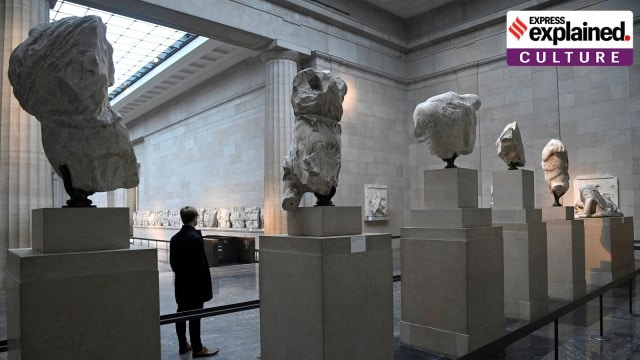What are the Elgin Marbles, at the centre of the row between Britain and Greece?
Over the years, Greece has repeatedly asked for the sculptures’ permanent return to Athens, but Britain and the British Museum have refused to do so. The latest controversy involves the British and Greek prime ministers, and King Charles.
 An employee views examples of the Parthenon Sculptures, sometimes referred to in the UK as the Elgin Marbles, on display at the British Museum in London, Britain, January 25, 2023. (Reuters/Toby Melville/File Photo)
An employee views examples of the Parthenon Sculptures, sometimes referred to in the UK as the Elgin Marbles, on display at the British Museum in London, Britain, January 25, 2023. (Reuters/Toby Melville/File Photo) British Prime Minister Rishi Sunak cancelled a meeting with his Greek counterpart Kyriakos Mitsotakis over the status of the Parthenon Sculptures housed at the British Museum, sparking a diplomatic row sparked between Greece and the UK on Monday (November 27).
Athens has accused London of trying to avoid discussing the contested sculptures, more popularly known as the Elgin Marbles. Over the years, Greece has repeatedly asked for the sculptures’ permanent return to Athens, but Britain and the British Museum have refused to do so.
Now, King Charles has seemingly waded into the controversy, sporting the blue and white tie and handkerchief — the colours of the Greek flag — on Friday, at the COP28 summit in Dubai. While Buckingham Palace insists that the choice of accessories was random, Prince Charles notably has a close relationship to Greece, with his father Prince Phillip coming from the Greek royal family.
Here is what you need to know about the Elgin Marbles, how they came to Britain, and the controversy surrounding them.
What are the Elgin Marbles?
The Parthenon Sculptures at the British Museum are more than 30 ancient stone sculptures from Greece that are more than 2,000 years old. Most of them originally adorned the walls and grounds of the Parthenon temple on the rocky Acropolis hill in Athens. Completed in 432 BC, the temple is dedicated to the goddess Athena and is seen as the crowning glory of Athens’ Golden Age.
While one notable sculpture, which is 75 metres long, depicts a procession for the birthday of Athena, others show gods, heroes or mythical creatures.
How did the sculptures reach Britain?
They were removed from the Parthenon in the early 19th century by Thomas Bruce, the 7th Earl of Elgin and then-British ambassador to the Ottoman Empire. The marbles were taken to Britain and purchased by the British Museum in 1816.
Were the sculptures stolen?
While Athen accused Lord Elgin of theft, he insisted he had permission to remove the marbles from the Ottoman Empire, which used to control Athen at the time. The original letter giving him permission, however, has been lost and its text remains disputed, according to a report by the BBC.
Athens has been demanding the return of the sculptures since it became independent in the early 1830s. The campaign gained momentum in the 1980s after Greek Oscar-nominated actress Melina Mercouri launched a movement for their return when she was culture minister between 1981 and 1989.
How did Britain respond?
The British Museum, the caretaker of the sculptures, claims that they were acquired by Elgin under a legal contract with the Ottoman Empire and has rejected the demands of their return.
Moreover, it also said that “the public would benefit more from having the sculptures divided between two museums, that bringing them back together into a unified whole is impossible as some parts were lost or destroyed, and that the sculptures could not be safely returned,” according to Reuters.
In March, Sunak said the marbles are a “huge asset” to the UK and ruled out changing a law that would allow the sculptures to be given back to Greece.
What happens now?
A day after the meeting was cancelled between Sunak and Mitsotakis, Greek officials said they would continue talks with the British Museum about the return of the Parthenon Sculptures.
Reports suggest that although the Tory government insists that Britain owns the marbles, the Labour party, expected to win next year’s national elections, will allow a loan agreement between the British Museum and the Greek government.
(With inputs from agencies)



- 01
- 02
- 03
- 04
- 05



































